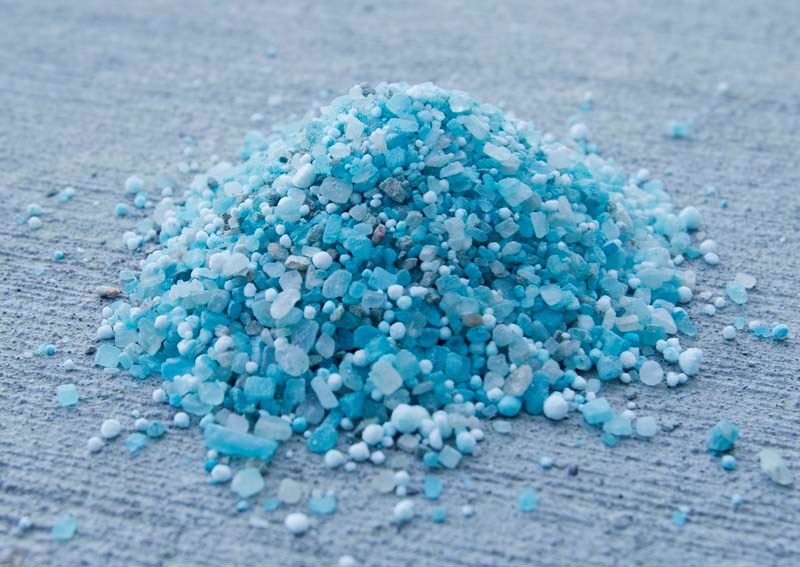This winter's pattern of snow, freezing rain and extended periods of thawing has caused icy havoc on city streets, sidewalks and driveways. Just as one weather front passes through, leaving behind it either snow or ice, another one piles on top with extra slush and more ice.
A St. Albert city bylaw states that failure to remove dangerous ice/snow from a sidewalk may result in a $100 fine, plus the city removing the dangerous condition and adding the expenses back to your property tax.
The bylaw doesn't explain how to get rid of several inches of ice on sloped sidewalks. For many homeowners, the easiest solution may appear to be salt-based ice melt, but what's the environmental impact of sodium chloride after it's used to clean up after a frozen winter such as this one?
At a municipal level, safety trumps all other concerns, especially when it comes to public roads. Use of salt is governed by the Canadian Environmental Protection Act, which states that the Government of Canada will not ban road salts and that road safety is the top priority. In Canada, about five million tonnes of road salts are used every year.
"In St. Albert, on average we use about 500 tonnes of salt per year. We use 5,000 tonnes of sand," said Leah Kongsrude, the city's manager of environment sustainability.
Every community uses different combinations of salt/sand on their roads, depending upon weather conditions, especially average winter temperatures.
Ice forms at zero degrees but with a 20 per cent solution of salt, ice forms at -16 C. When it's colder, the sodium chloride has little effect on melting ice.
Ottawa and Toronto have experimented with using BEET 55 on their highways. The province of British Columbia is also experimenting with the substance, which is left over after making sugar from sugar beets, on its Coquihalla Highway.
The theory behind using the beet juice is that it reduces the amount of salt used on roads. When it is used, BEET 55 is generally sprayed on roads in anticipation of a storm, and usually the road is already dry.
St. Albert is unlikely to try beet juice, Kongsrude said, because our average temperatures are colder and the roads are seldom dry in the winter.
"Typically BEET 55 is used in municipalities which use 100 per cent brine to de-ice their streets. They use salt instead of sand because of the temperatures they have but also because salt is inexpensive and you don't have to clean it up in the spring. The BEET 55 works like antifreeze and it lowers the freezing point," Kongsrude said.
Hard on plants
Salt that is layered on the sidewalk or driveway could have a detrimental effect on the grass and plants.
"Studies have shown that near roadways the salinity caused vegetation changes similar to a sea shore," said Prof. Lee Foote, director of the Devonian Botanic Garden.
"Different plants have a different tolerance for salt. Salt causes ionic stress, and kills the plants from the inside out and it also changes the osmotic balance of how much water the plant can draw into the cells."
Salt does not biodegrade so it stays in the soil or it washes into the sewage system and later the river.
"Sodium chloride is the most burning salt. It's a good ice melter but it's also a good cell destroyer of plants. Salt creates ionic decomposition of concrete. You can tell the people on the street who use a lot of salt because they end up with pitted cement and loose rocks," Foote said.
Salt that is washed away in the sewer system is usually fairly dilute by the time it gets to the river, Foote said.
"Most of the sidewalk salt is washed and diluted by the time it gets to the river, especially if there is a big snow dump. If that didn't happen, a lot more plants would die," he said.
"Kentucky bluegrass is a rhizome, and it will come back eventually," Foote said, adding that the salt could kill shrubs or trees.
Some commercial salt mixes include calcium chloride as well as sodium chloride. The addition of calcium chloride seems to lower the freezing point, so these kinds of salt mixes do a better job of dissolving ice at colder temperatures. Calcium chloride is not as hard on plants, said Prof. Miles Dyck of the University of Alberta's department of renewable resources.
"Calcium chloride is better for the soil structure, but it is more expensive," he said. "You still have to use it in moderate levels because you could still develop excess salinity."
For homeowners who don't want to use salt, the traditional ice chipper is an option. Tongue-in-cheek, Dyck suggested pouring sugar on the steps might help to de-ice them in the same way that salt does.
"When ice forms, the water molecules are closer together. Impurities between the molecules – such as salt or sugar – alter the freezing point. In reality, the beet juice is sugar," he said.
"You could boil up a bunch of beets I guess," Kongsrude said. "You could use cheese brine. I've heard that's what they use in Wisconsin. You could pour vodka on the steps and that might help. I wish there was a cure-all for ice but there really isn't one."
Where does it come from?
Much of the salt used in Alberta comes from the K&S Windsor Salt Ltd. mine and plant near Elk Point (about 200 kilometres east of St. Albert).
The site is home to a 300-foot-thick salt bed located 2,600 feet below ground. It was discovered through oil and gas exploration. It's estimated that there is enough salt in this bed to supply all of Canada for the next 2,000 years.
Source: Elk Point Historical Society
Fun salt fact
The word salary is derived from the Roman word for salt. Expressions such as "worth their salt" come from the days when workers were paid wages with salt.




